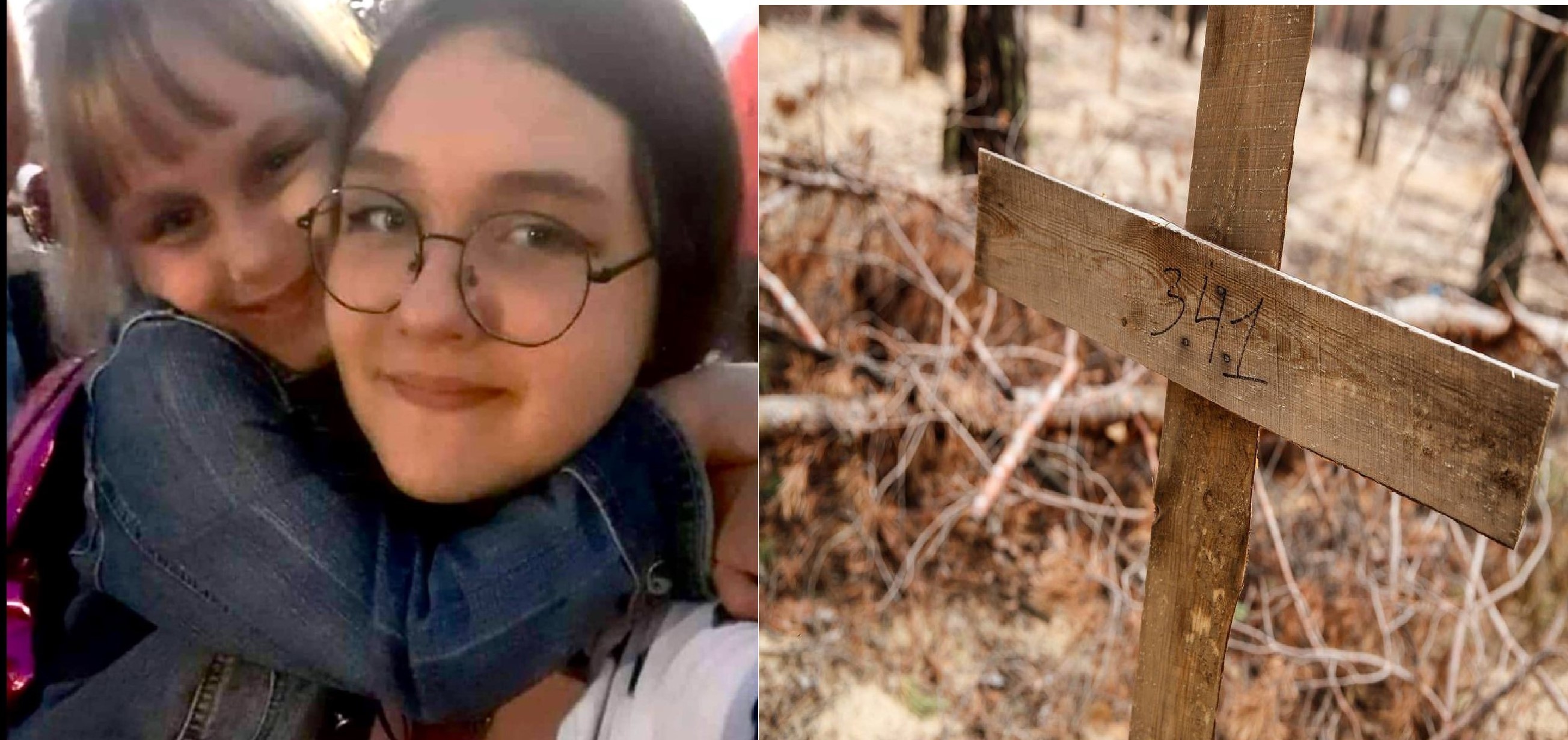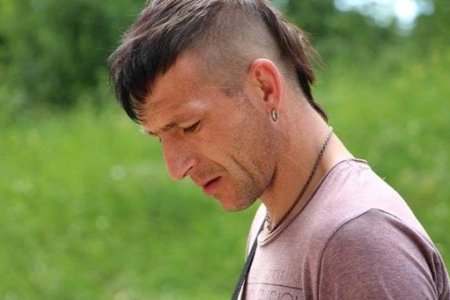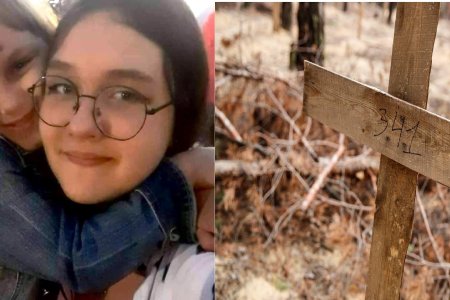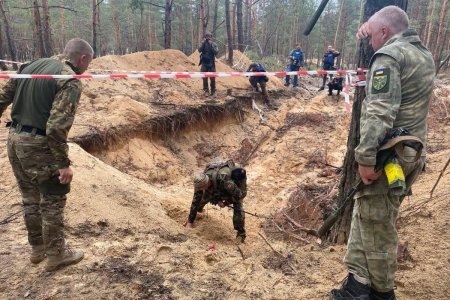
47 civilians, many of them children, were killed in just one of the missile strikes on Izium, in Kharkiv oblast, that Russia continues to claim it is directing only at military targets. Some might have been saved had the relentless Russian shelling not prevented any rescue efforts.
It will soon be a year since the missile strike on an apartment block on Pershotravneva St in Izium. The Russian missile struck at around 7 a.m. on 9 March, causing the building to collapse on the basement where residents had hoped to find shelter. Almost all members of two families, including three children, were killed, though the full scale of the tragedy only became clear with the discovery of the mass burial site in the forest outside Izium after the Russians were driven out in September 2022. 5-year-old Lesia Stolpakova was killed, together with her half-sister Oleksandra (Paniukhno), who was just 8, their mother Olena Stolpakova and her husband Dmytro Stolpakov. Olena’s 13-year-old sister Marika (Masha) Zhykhariova also died, together with the two sisters’ parents Oleksandr Zhykhariov and Tetiana (or Natalia) Zhykhariova. The Russians also murdered Lesia’s great-grandmother Liudmyla Sokol
Oleksandr Zhykhariov had tried to persuade his 71-year-old mother, Halyna Zhykhariova to join them in the basement, which they had hoped would serve as a safe bomb shelter. She had refused, saying it was too far to walk.
Halyna alone survived. She spoke later to journalists from Graty, explaining that her son had last phoned on 6 March, repeating again that she should come, saying that it was warm in their basement, and they had a lot of food. After that there was no contact.
“On 11 March, I was told that a bomb had hit Sasha’s apartment block. I ran there immediately and found only rubble. The debris was not being cleared because they were bombing. I came for several days and kept waiting for when they would begin digging. They only began to clear the rubble after almost a month, in the first days of April when the Russians had already occupied the city and the bombing stopped.”
“I would arrive at 8 in the morning and leave at 3 in the afternoon when the rescuers finished their work. I helped to identify the people as I knew everybody in Sasha’s block. I supported people who were searching for their loved ones. Two firemen became unwell, and I gave them heart drops. I held up before I had to find my family. They dug out 47 bodies. Seven were buried unidentified, and another seven were not found – they found their documents, but not the bodies. Presumably the bomb destroyed them. Of my people, I recognized only six. I didn’t find my daughter-in-law Natasha and 13-year-old granddaughter Masha. There were no faces. All the bodies were blackened, burned, you couldn’t even recognize them from their clothing. I recognized my elder granddaughter and her husband by their tattoos. Only my son’s head was in place. He was thrown by the explosion under a pipe – the rescuers sawed the pipe apart. The last person they found was my daughter-in-law’s mother. She had her documents, but no face. However, I know her well, the children were together for 31 years.”
Halyna has almost no photos of the family she lost. Most of them were in the telephones that were not found. Only her elder granddaughter Olena’s phone was intact, but that is coded, and she doesn’t know how to unblock it.
436 bodies were exhumed from the mass burial site outside Izium, with most of them having died a violent death, and 30 showing signs of having been tortured. Many of the bodies had been buried under merely a number, and the process of identifying them is long, with families who lost loved ones having provided DNA samples.
It was only through DNA that it became possible to confirm that ‘the body buried as No. 319 of the graves in the Izium forest was that of the Kharkiv oblast poet, children’s writer and Ukrainian patriot Volodymyr Vakulenko. He had been seized by the Russians in March 2022 and murdered.
Not all the slain victims of Russian aggression were buried at the Izium burial site. At the end of January 2023, investigators reported that at least 400 bodies remained unidentified, with this figure also including many of those found at the scene of other horrific crimes where, for example, nine civilians were killed when the Russians opened fire on two evacuation buses.
The Graty journalists also spoke with several civilians who had been seized and tortured by the Russians. 73-year-old Leonid Shchybria is an artist and civic activist who is well-known in Izium. Although he may have been targeted for his pro-Ukrainian views, the Russians were clearly intent on stealing whatever they could, including the family’s two cars. When they burst into Shchybria’s home the first time, they beat him, demanding that he give them money. He believes that they began accusing him of political activities, reeling off names he’d never heard of, because it made it easier for them to rob him. On that occasion, the Russians did not take him away.
Both Leonid and his wife, Tamara, sustained injuries during the Russian bombing of the city. He recalls seeing Russians driving in the family’s cars as he dragged himself on foot to the local hospital to get his injuries bandaged.
After the next armed search, the Russians took him away. He asked them what they wanted of him, a 73-year-old, but they ignored him and threw him into a basement which they were using to imprison – and torture – civilians. He was held with a person who was not given any food for eight days. In Shchybria’s case, he was held without anything for three days.
53-year-old Oleksandr Hlushko had served as an army driver during the earlier military conflict in Donbas and was an obvious target for the Russians. He was imprisoned after they burst into his home, but did initially manage to escape, only to be seized again. He was beaten on the soles of his feet so badly that can still scarcely walk. He says that when they decided that he was close to death, they took him out of the basement and left him in some bushes on the side of the road to die. His groans were heard by a local woman who called neighbours who rescued him, however his condition worsened and, after ten days, he had to go to hospital. He was admitted then under a false name and treated there, in the basement, by Doctor Yury Kuznetsov for a month and a half. Unfortunately, the Russians found out that he had survived and came for him again.
“I was held in a temporary holding unit in the police station. Prisoners there changed all the time, and they ill-treated all of them. I was tortured with electric currents – they put clamps on my fingers and then pressed the button, while also hitting me with a metal helmet around the head. I still can’t feel the skin on my head in those places, my legs are battered, and feet pound… One of the butchers, who had a Chechen accent, jumped over me and broke two ribs.”
Oleksandr Tereshchenko, head of the local branch of the Svoboda Party and an assistant to an MP, was held and tortured by the Russians for 31 days. He too mentions beatings, electric currents, as well as not being given enough to eat.
“FSB [Russian security service] men worked in the basement. They put pressure on people so that they would sign agreements to collaborate, betraying their neighbours… This was a constant conveyor belt, with new people brought there all the time and torture. There was a woman in the next cell, who was about 50. They were accusing her of being a sniper because they’d seen blisters on her fingers. There was a child in the house when she was seized. She begged them to at least take the child to the neighbours. She sobbed all night, but they didn’t release her, holding her for five days.”
The Russians demanded that Tereshchenko sign documents claiming that the Americans were to blame for the war, that they had provoked the Russians and that it wasn’t the Russians who had invaded Ukraine. As he said, when they put a pistol to your head, you’ll say whatever they want. They got him to put a Svoboda Party jacket on and videoed this grotesque nonsense, posting it on YouTube. They had promised that if he did the video, they’d release him, but then they changed this, saying that they’d release him if he betrayed others. He was then taken out for what proved to be a mock execution.
Tereshchenko says that he would not be able to identify his torturers as they were all in masks, with only their eyes visible. “They violate all possible laws, and therefore they hide behind masks.”
These are only a small number of the civilians whom Russian seized, imprisoned and tortured during their occupation of parts of the Kharkiv oblast. The crimes they committed, and, probably, the bodies of their victims, have probably not all been uncovered.
On 16 September 2022, the authoritative Institute for the Study of War noted that “the revelations of mass graves of civilians and torture chambers in newly liberated Izyum confirm ISW’s previous assessments that the Bucha atrocities were not isolated war crimes but rather a microcosm of Russian atrocities throughout Russian-occupied areas.”
It is the Russians who have made it clear that any negotiations with the aggressor state can only be with Russia driven out of every last piece of Ukrainian territory.



